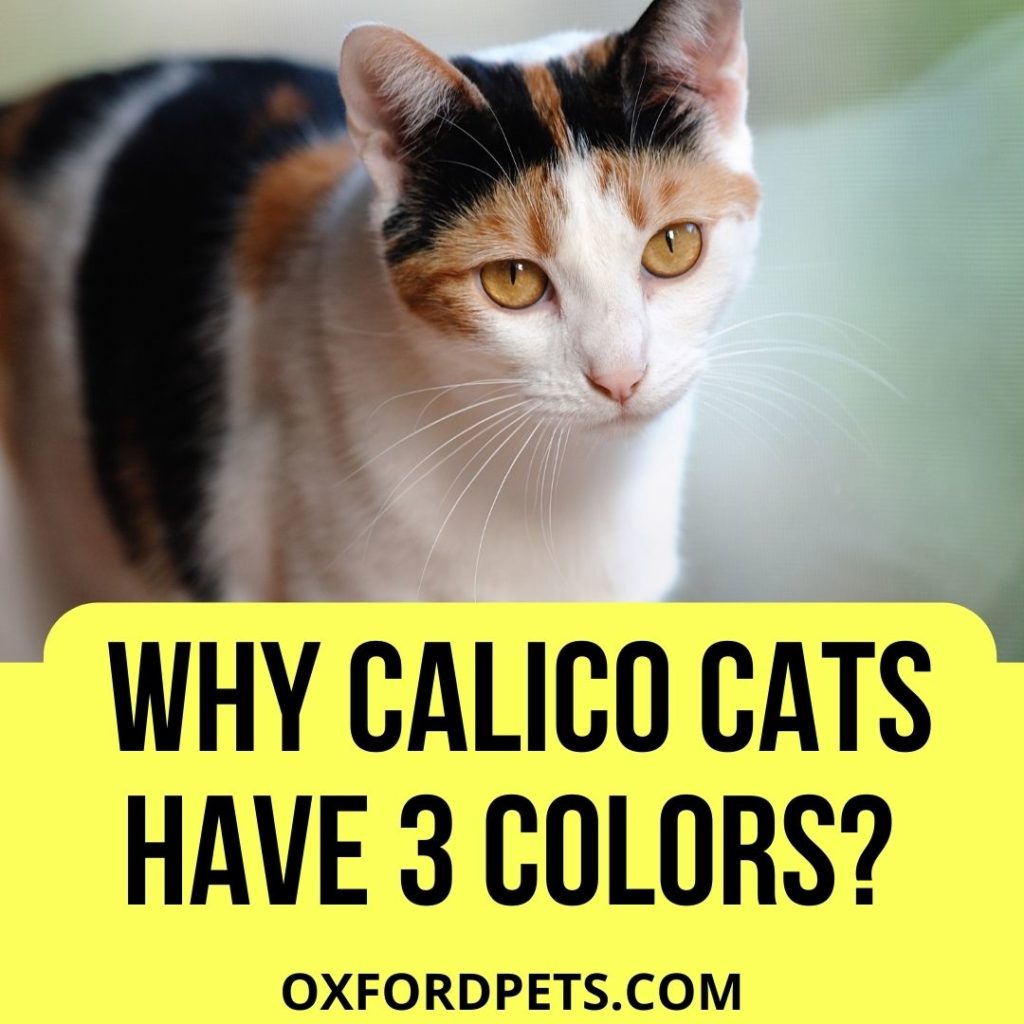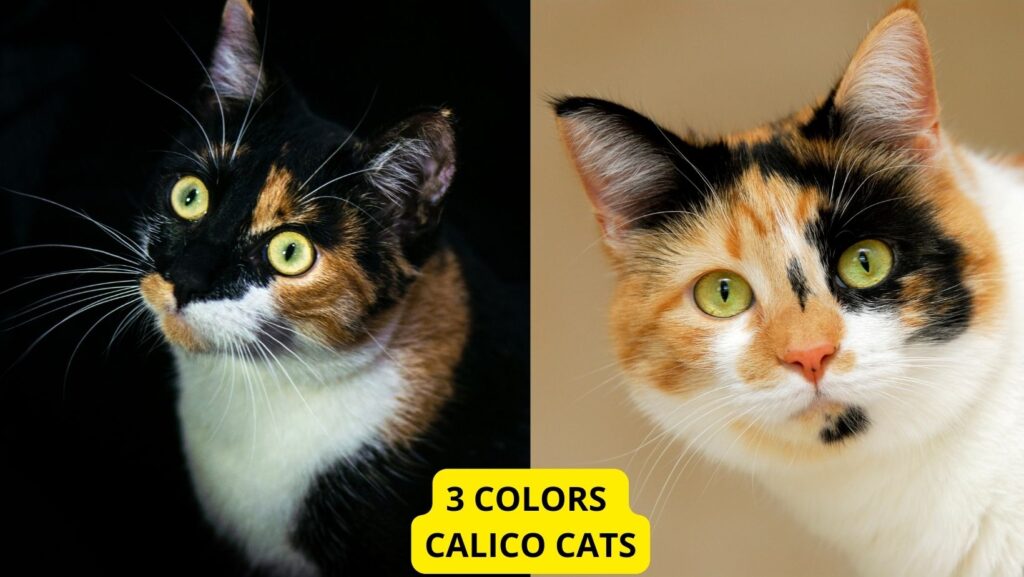Have you ever wondered how cats get their fur colors? Cats have lots of color varieties. Some are jet black, snowy white, grey with stripes, and can even be orange with a bullseye on their side.
But the coolest cats are the calicoes because they have three different colors of fur and that is not a simple feat! So, why do calico cats have three colors? GENETICS, of course! Let’s take a look at what it takes for a cat to be born a super cool calico!

Contents
How Fur Color in Cats is Determined
Fur color in cats is found on the X-chromosome.
Okay, just in case it has been a while since biology class…quick review. All mammals have chromosomes that determine gender called the X-chromosome and the Y-chromosome.
Females are given an X-chromosome from both parents (XX). Males are given an X-chromosome from the mother and a Y-chromosome from the father (XY). In cats, color is found only on the X-chromosome.
These chromosomes have genes that can be dominant or recessive. Dominant usually means that it determines the outcome and recessive usually means that it doesn’t, unless…
- There are two Dominant genes. Since they are both dominant, the both are seen in the fur.
- There are two Recessive genes and no dominant genes.
- This means that rather than black, the cat may be chocolate colored. It may mean that instead of orange, the cat may be brown.
Keep in mind…there are exceptions to lots of genetic rules! But wait, there’s more!
There are other genes found on the X-Chromosome that determine variation in color such as…
- how much color pigment the fur will hold
- whether the fur, and probably skin and eyes, will have color or total lack of color (albinism)
- In case, white fur will be present in spots (piebald)
- whether the fur will be completely white regardless of any other color gene (not albinism).
How Fur Patterns in Cats are Determined
Fur patterning is found on the X-chromosome as well. Some cats are solid-colored with no color differences or patterns. Others are, well…all mixed up!
Have you ever seen a cat wearing a little black and white tuxedo? How about completely white except for between his ears and the tip of his tail? Or the solid colored cat with little white booties?
Then there are the Tabbies. Tabby cats can have many different patterns in their furs like swirls, stripes, spots, or bands.
A combination of the coloration and patterning genes helps give a cat its nearly unique look.

The Tri-Colored or Calico Cat
Calico cats have three colors of fur. They often have the colors orange and black, and lots of white.
Sometimes the colors might be less bold like ginger or gray due to genes that change how much color the fur holds.
Rather than the fur being only orange or black because of a single dominant gene, the genes both contribute to fur color because they are equally dominant. This is called co-dominance.
Remember, the gene for color is on the X-chromosome. Females have two chances for color, not three!
The key to the calico cat is the white.!
Calico cats also have the gene mutation that leads to white spotting on the fur and skin. This is commonly referred to as piebald. Believe it or not, many mammals share this mutation, including humans!
Since tri-colored fur requires two X-chromosomes, the majority of calico cats are female. They are as healthy as any other cat, and to many, the most beautiful.
Since male cats have only one X-chromosome, can you have a calico male? Yes and no! Some cats may appear to be male (XY), but actually have two X-chromosomes (XXY). These male cats are very rare and usually cannot reproduce. However, they have everything they need to be calico!
This condition for calico males is called Klinefelter’s Syndrome. Unless this type of male cat is calico or your wish to use him for breeding doesn’t work out, his XXY genetics are likely to go unnoticed.
Except for possible behavioral difficulties, calico males will generally be as healthy as other male cats initially. Older male calico cats may develop medical problems such as bones that break easily and possible joint, heart, and insulin issues related to increased obesity.
Predicting Color Outcomes in Kitten Litters
You just might be tempted to try selective breeding to get the color kitten you want…especially if you want a calico kitten!
Hold on a minute…we need to talk.
Since a male-only has one X-chromosome, his mother determines his fur color. So if his mother is orange or black, you would expect him to be orange or black. It is just not that simple!
Since his mother had two X-chromosomes, her fur may not show both chromosomes. He is only going to get one X-chromosome and it may not be the one that determined his mother’s fur color.
Females will get two X-chromosomes, one from each parent. If one parent is orange or black, chances are that the female will be orange or black. However, if one parent is orange and one is black, chances do increase that a calico could be born because these colors are co-dominant.
And, just because your female cat is calico, it doesn’t mean her kittens will be! When you consider gene mutations, variations, and possible fur patterns, you realize your task to determine the color of your kittens may be difficult. These genetic differences make predicting kitten color outcomes very unlikely.
However, if you really want to know your cat’s genetic profile, there are companies that will provide testing to determine your cat’s genetics…including genes that determine fur color.
- Can Calico Cats Have Babies? (Are They Infertile?)
- Are Calico cats Good Luck Charms?
- Wondering, How and Why Do Calico Cats Get Fat?
So, Why do Calico Cats have Three Colors?
Calico cats have three colors because they are cool cats! In fact, many cultures think they are lucky. They are certainly beautiful.
Maybe all of that is true, but calico cats have three colors because they have cool genetics! The incredibly complex way fur color is determined is what gives cats their delightful coloration and patterning.
All cats are beautiful. But when you realize how unique the calico cat actually is, you appreciate them just a little bit more.
![Why Do Calico Cats Have Three Colors? [6 Reasons]](https://oxfordpets.com/wp-content/uploads/2022/04/Why-Do-Calico-Cats-Have-Three-Colors.jpg)